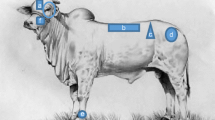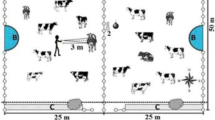Abstract
This work aimed at characterizing the thermal balance of Nellore cattle from the system of indirect calorimetry using a facial mask. The study was conducted at the Animal Biometeorology Laboratory of the São Paulo State University, Jaboticabal, Brazil. Five male Nellore weighing 750 ± 62 kg, at similar ages and body conditions were distributed in four 5 × 5 Latin squares (5 days of records and five schedules) during 20 days. Physiological and environmental measurements were obtained from the indirect calorimetry system using a facial mask. Respiratory parameters, hair coat, skin, and rectal temperature were continuously recorded. From this, metabolic heat production, sensible and latent ways of heat transfer were calculated. Metabolic heat production had an average value of 146.7 ± 0.49 W m−2 and did not change (P > 0.05) over the range of air temperature (24 to 35 °C). Sensible heat flow reached 60.08 ± 0.81 W m−2 when air temperature ranged from 24 to 25 °C, being negligible in conditions of temperature above 33 °C. Most of the heat produced by metabolism was dissipated by cutaneous evaporation when air temperature was greater than 30 °C. Respiratory parameters like respiratory rate and ventilation remained stable (P > 0.05) in the range of temperature studied. Under shade conditions and air temperature range from 24 to 35 °C, metabolic heat production, respiratory rate, and ventilation of mature Nellore cattle remain stable, which is indicative of low energetic cost to the thermoregulation.





Similar content being viewed by others
References
Beatty DT, Barnes A, Taylor E, Pethick D, McCarthy M, Maloney SK (2006) Physiological responses of Bos taurus and Bos indicus cattle to prolonged, continuous heat and humidity. J Anim Sci 84:972–985
Brouwer E (1965) In Energy metabolism. [K L Blaxter, editor]. London: Academic Press. Weast, R. C. (editor) (1970-1). The handbook of chemistry and physics. 51st ed. Cleveland, Ohio: Weir, J. B. de V.(1949). J. Phyd., Land. 109, p. 41
Camerro LZ, Maia ASC, Chiquitelli Neto M, Costa CCM, Castro PA (2016) Thermal equilibrium responses in Guzerat cattle raised under tropical conditions. J Therm Biol 60:213–221
Collier RJ, Gebremedhin KG (2015) Thermal biology of domestic animals. Annu Rev Anim Biosci 3:10–20
da Silva RG (2000) Um modelo para a determinação do equilíbrio térmico de bovinos em ambientes tropicais. Braz J Anim Sci 29:1244–1252.
da Silva RG, LaScala N Jr, Lima Filho AE, Catharin MC (2002) Respiratory heat loss in the sheep: a comprehensive model. Int J Biometeorol 46:136–140
da Silva RG, Guilhermino MM, Morais DAEF (2010) Thermal radiation absorbed by dairy cows in pasture. Int J Biometeorol 54:5–11
daSilva RG, La Scala Jr N, Tonhati H (2003) Radiative properties of the skin and haircoat of cattle and other animals. Trans ASAE 46:913–918
daSilva RG, Maia ASC (2013) Principles of animal biometeorology. Springer, New York Ed. 1
Finch VA (1985) Comparison of non-evaporative heat transfer in different cattle breeds. Aust J Agric Res 36:497–508
Fonsêca VFC, Saraiva EP, Maia ASC, Nascimento CN, Silva JA, Pereira WE, Almeida MEV, Pimenta Filho EC (2016) Models to predict both sensible and latent heat transfer in the respiratory tract of the Morada Nova sheep under semiarid tropical environment. Int J Biometeorol. doi:10.1007/s00484-016-1255-3
Gaughan JB, Mader TL, Holt SM, Josey MJ, Rowan KJ (1999) Heat tolerance of Boran and Tuli crossbred steers. J Anim Sci 77:2398–2405
Gebremedhin KG, Cramer CO, Porter WP (1981) Predictions and measurements of heat production and food and water requirements of Holstein calves in different environments. Trans ASAE 3:715–720
Gebremedhin KG, Hillman PE, Lee CN, Collier RJ, Willard ST, Arthington JD, Brown-Brandl TM (2008) Sweating rates of dairy cows and beef heifers in hot conditions. Transaction of the ASABE 51:2167–2178
Gebremedhin KG, Lee CN, Hillman PE, Collier RJ (2010) Physiological responses of dairy cows during extended solar exposure. Trans ASABE 53:239–247
Gonzalez JE, Blaxter KL (1962) The metabolism and thermal regulation of calves in the first month of life. Brit J Nutr 16:199–212
Hansen PJ (2004) Physiological and cellular adaptations of zebu cattle to thermal stress. Anim Reprod Sci 83:349–360
Harvey W R (1960) Least-squares analysis of data with unequal subclass numbers, Beltaville: U.S.D.A, n° 20–8
Holmes CW, McLean NA (1975) Effect of air temperature and air movement on the heat produced by young Friesian and Jersey calves, with some measurements of the effects of artificial rain. N Z J Agric Res 18:277–288
Incropera FP, DeWitt DP, Bergagman TL, Lavine AS (2013) Fundamentals of heat and mass transfer. J. Wiley, New York
Kibler H H, Brody S (1956) Influence of diurnal temperature cycles on heat production and cardiorespiratory activities in Holstein and Jersey cows. Research bulletin 601, University of Missouri College of Agriculture Agricultural Experiment Station, February
Lighton JRB (2008) Measuring metabolic rates: a manual for scientists. Oxford University Press, New York 201p
Littell RC, Freund RJ (1991) Spector, P. C. SAS® System for Linear Models, third edition. SAS Institute Inc, Cary, NC 329p
Maia A S C, Gebremedhin K G, Nascimento S T, Carvalho M D, Simão B R, Camerro L Z, Chiquitelli Neto M (2014) Development of facial masks for indirect calorimetric studies for livestock. ASABE and CSBE/SCGAB Annual International Meeting Sponsored by ASABE—Montreal, Quebec, Canada
Maia A S C, Silva RG, Loureiro C M B (2005a) Sensible and latent heat loss from the body surface of Holstein cows in a tropical environment. Int J Biometeorol 50:17–22
Maia AS, da Silva RG, Loureiro CMB (2005b) Respiratory heat loss of Holstein cows in a tropical environment. Int J Biometeorol 49:332–336
Milan HFM, Maia ASC, Gebremedhin KG (2016) Technical note: device for measuring respiration rate of cattle under field conditions. J Anim Sci, v 94:1–5
McLean JA (1963a) Measurement of cutaneous moisture vaporization from cattle by ventilated capsules. J Physiol 167:417–426
McLean JA (1963b) The partition of insensible losses of body weight in heat from cattle under various climatic conditions. J Physiol 167:427–447
McLean JA (1972) On the calculation of heat production from open circuit calorimetric measurements. Br J Nutr 27:597–600
McLean JA, Whitmore BA, Young BA, Weingardt R (1984) Body heat storage, metabolism and respiration of cows abruptly exposed and acclimatized to cold and 18 °C environments. Can J Anim Sci 64:641–653
McManus C, Castanheira M, Paiva SR, Louvandini H, Fioravanti MCS, Paludo GR, Bianchini E, Corrêa PS (2011) Use of multivariate analyses for determining heat tolerance in Brazilian cattle. Trop Anim Health Prod 43:623–630
McManus C, Prescott E, Paludo GR, Bianchini E, Louvandini H, Mariante AS (2009) Heat tolerance in naturalized Brazilian cattle breeds. Livest Sci 120:256–264
NRC (1981) Effect of environment on nutrient requirements of domestic animals. National Academy Press, Washington, D.C.
Richardson EC, Herd RM, Oddy VH, Thompson JM, Archer JA, Arthur PF (2001) Body composition and implications for heat production of Angus steer progeny of parents selected for and against residual feed intake. Aust J Exp Agric 41:1065–1072
Santos SGCG, Saraiva EP, Pimenta Filho EC, Gonzaga Neto S, Fonsêca VFC, Pinheiro AC, Almeida EV, Amorin MLC (2017) The use of simple physiological and environmental measures to estimate the latent heat transfer in crossbred Holstein cows. Int J Biometeorol 61:217–225
SAS Institute (1995) User’s guide: statistics. Version 6.(10 edition).SAS Institute Inc., Cary, NC. 295 pp.
Schleger AV, Turner HG (1965) Sweating rates of cattle in the field and their reaction to diurnal and seasonal changes. Aust J Agric Res 16:92–106
Schrama JW, Van der Hel W, Arieli A, Verstegen MWA (1992) Alteration of energy metabolism of calves fed below maintenance during 6 to 14 days of age. J Anim Sci 40:2527
Steketee J (1973) Spectral emissivity of skin and pericardium. Phys Med Biol 18:686
Thompson M L (1962) “Melanins”. In: Comparative biochemistry. New York: Academics Press, Vol. 3
Acknowledgements
This study was supported by the Fundação de Amparo à Pesquisa do Estado de São Paulo (FAPESP), process numbers 2011/17388-6 and 2011/16695-2.
Author information
Authors and Affiliations
Corresponding author
Ethics declarations
This research was reviewed and approved by the Sao Paulo State University Animal Care and Use Committee before the study started (Process number: 17.519/14).
Rights and permissions
About this article
Cite this article
de Melo Costa, C.C., Maia, A.S.C., Nascimento, S.T. et al. Thermal balance of Nellore cattle. Int J Biometeorol 62, 723–731 (2018). https://doi.org/10.1007/s00484-017-1349-6
Received:
Revised:
Accepted:
Published:
Issue Date:
DOI: https://doi.org/10.1007/s00484-017-1349-6




